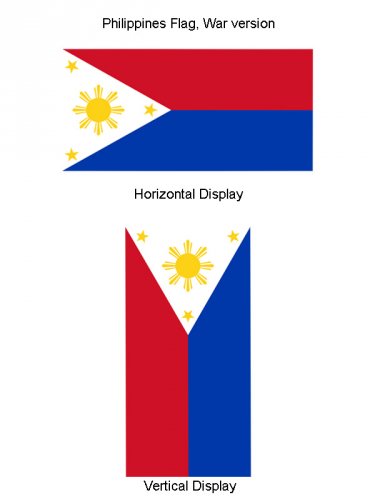
X Close Categories
BCategories
Philippines
The flag of the Philippines is one of my favorites. Using the three primary colors (yellow, blue, red) the design is bold yet simple and most importantly for a flag- easily recognizable. The flag design is full of meaning and best of all (in my opinion)- well documented!
Want to know the exact color? Not a problem. Want to know the meaning or exact construction specifications? Again not a problem. The government of the Philippines has been wonderful about producing clear documentation on the use, meaning, design and description of the flag.

On March 25, 1936, then President Manuel L. Quezon issued E.O. No. 23 prescribing the technical description and specification of the Filipino Flag. It was followed by other directives assigning the National Historical Institute as the authority in Philippine Vexillaries and Heraldry.
- The white triangle with equal sides of the flag is symbolic of equality among men.
- The sun represents the gigantic strides that have been made by the Sons of this land on the road to progress and civilization.
- The eight rays of the sun in the triangle represent the first eight united provinces that revolted for our independence (Batangas, Bulacan, Cavite, Laguna, Manila, Nueva Ecija, Pampanga, and Tarlac).
- The three stars in the triangle stand for the three major geographical divisions of the country - Luzon, Visayas and Mindanao.
- The red field symbolizes the willingness of the Filipino people to shed blood in defense of their country.
- The blue field stands for common unity and the noble aspirations of the Filipino people.
- The white field stands for purity.

A number of years ago a customer from the Philippines brought to my attention the fact that the Philippines flag was also designed to have a specific war and peace version. Used as a flag and displayed horizontally the peace version (rather standard version) has blue on top. In times of war the red is on top. Now, one would think to translate that to vertical standards you would just rotate the flag 90 degrees, but not so. In the world of flags the position of honor is always on the observers left (or the flag’s right). So when rotated 90 degrees that would put the red on the observers left (which is used in times of war). The correct vertical display of the standard Philippines flag (or peace version) actually has the blue stripe on the observers left.
In otherwords:
http://www.gov.ph/1950/06/12/executive-order-no-321-s-1950 Section 1, Paragraph 4: The Flag, if flown from a flagpole, should have its blue field on top in time of peace and the red field on top in time of war; if in a hanging position, the blue field should be to the right (left of the observer) in time of peace, and the red field to the right (left of observer) in time of war

